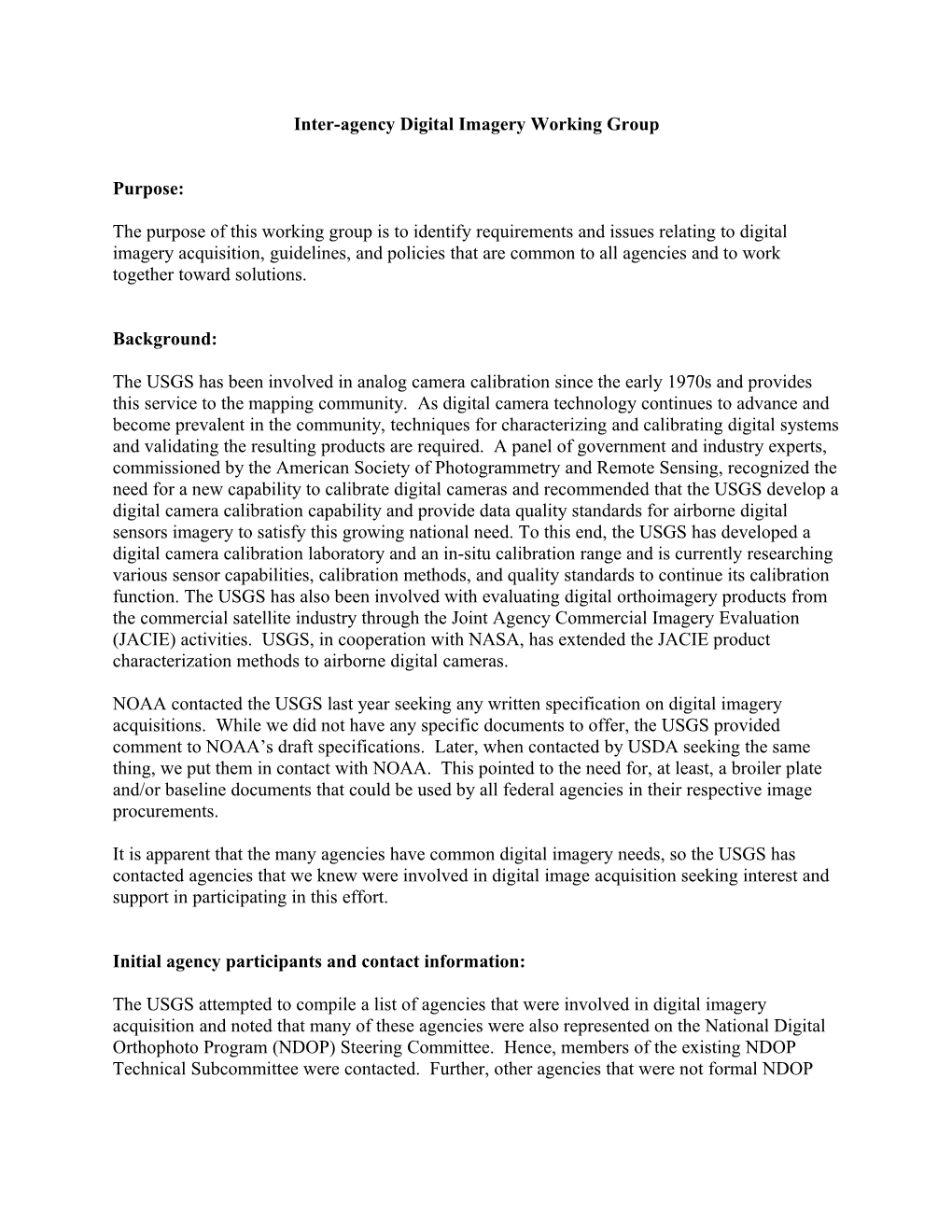Inter-agency Digital Imagery Working Group
Purpose:
The purpose of this working group is to identify requirements and issues relating to digital imagery acquisition, guidelines, and policies that are common to all agencies and to work together toward solutions.
Background:
The USGS has been involved in analog camera calibration since the early 1970s and provides this service to the mapping community. As digital camera technology continues to advance and become prevalent in the community, techniques for characterizing and calibrating digital systems and validating the resulting products are required. A panel of government and industry experts, commissioned by the American Society of Photogrammetry and Remote Sensing, recognized the need for a new capability to calibrate digital cameras and recommended that the USGS develop a digital camera calibration capability and provide data quality standards for airborne digital sensors imagery to satisfy this growing national need. To this end, the USGS has developed a digital camera calibration laboratory and an in-situ calibration range and is currently researching various sensor capabilities, calibration methods, and quality standardsto continue its calibration function.The USGS has also been involved with evaluating digital orthoimagery products from the commercial satellite industry through the Joint Agency Commercial Imagery Evaluation (JACIE) activities. USGS, in cooperation with NASA, has extended the JACIE product characterization methods to airborne digital cameras.
NOAA contacted the USGS last year seeking any written specification on digital imagery acquisitions. While we did not have any specific documents to offer, the USGS provided comment to NOAA’s draft specifications. Later, when contacted by USDA seeking the same thing, we put them in contact with NOAA. This pointed to the need for, at least, a broiler plateand/or baseline documents that could be used by all federal agencies in their respective image procurements.
It is apparent that the many agencies have common digital imagery needs, so the USGS has contacted agencies that we knew were involved in digital image acquisition seeking interest and support in participating in this effort.
Initial agency participants and contact information:
The USGS attempted to compile a list of agencies that were involved in digital imagery acquisition and noted that many of these agencies were also represented on the National Digital Orthophoto Program (NDOP) Steering Committee. Hence, members of the existing NDOP Technical Subcommittee were contacted. Further, other agencies that were not formal NDOP members were also contacted (i.e., NASA, COE, NOAA, FWS). The following have expressed an interest in participating or working with the committee:
USGS (Greg Stensaas, 605-594-2569, ; George Lee, 650-329-4255, )
FSA (Geoff Gabbot, 801-975-3500, ext. 207,; John Mootz, 801-975-3500, ext. 284, )
NRCS (Tony Kimmett, 817-509-3434, )
BLM (Russ Jackson, 303-239-3656, )
NASA (Tom Stanley, 228-688-7779,)
COE (Dave McDaniel, 504-862-2614, )
NOAA (Stephen White, 301-713-1428, ext 167, )
FWS (Brian Huberty, 612-713-5332, )
NGA (Len LaFeir, 703-735-3533, )
Getting started:
In order to get started, we propose starting with an introductory teleconference to define the scope and intent of the working group. The discussion will also include a discussion of our mode of operation, brief agency exchange, and other administrative organizing logistics. A preliminary agenda for the initial teleconference includes:
- Introductions
- Background leading to proposal to establish working group
- Membership of working group (i.e., Have we got the right group? Are there others?)
-How does group operate (e.g., Do we need a face-to-face kick-off meeting?; Do we operate entirely by telecons?; Are meetings and telecons ad hocor scheduled?, etc).
- Do we need any face-to-face meetings? (e.g., kick-off, ad hoc, or annual?)
- How does the group report or communicate on-going activities and accomplishments?
- Agency roundtable overviews to include explanation of needs, completed work, and other related activities (e.g., standards, evaluations, and quality assurance of digital image acquisitions)
Recommended initial task:
Develop a federal boilerplate specification document and digital imagery guidelines for digital image acquisition by:
- Writing the initial draft documents.
- Hosting a workshop for data providers and equipment manufacturers to present draft specification and guidelines and to invite comment.
- Finalize documents and make document available to general mapping community.
- Communicate the results in public forums.
Initial work schedule:
- Initial telecon before Thanksgiving.
- Follow-up telecom before Christmas.
- Face-to-face meeting sometime in January.
- Working telcons as needed prior to the ASPRS conference in Baltimore in March.
- Have a working meeting prior to the ASPRS conference.
Future tasks:
- Develop federal policy on camera calibration, both analog and digital.
- Develop site for FAQs on digital imagery for mapping applications.
- Develop similar acquisition specifications for other sensors (LIDAR, IFSAR, etc).
Proposed next steps: TBD
Working Group Coordinator:
Phil Rufe, USGS, 573-308-3540,
